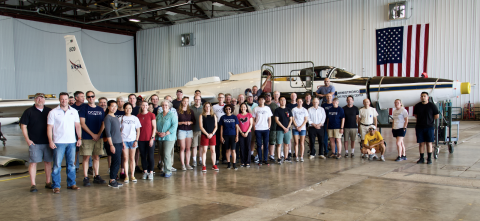BY JOHN CARTER JR
Images courtesy DCOTSS Project Website
Over the past summer, NASA began conducting research for the Dynamics and Chemistry of the Summer Stratosphere (DCOTSS) project. The project is a NASA Earth Venture Suborbital research project and aims to learn more about the strong convective storms that overshoot the tropopause in the United States. The project uses the NASA ER-2 high altitude research aircraft, the flights of which were held in Salina. These aircraft had instruments used to measure trace gases and aerosol properties.

Retired FHSU Professor of Chemistry Dr. Stephen Donnelly is worked on the project, alongside participants from NASA, Harvard, Texas A&M, University of Oklahoma, University of Miami, Purdue University, and others.
According to Donnelly, there are 12 instruments tucked away in various locations on the aircraft. This image above shows the instruments in the lab space after being removed from the aircraft with the nose and tail cones removed. Donnelly, who works with the Advanced Whole Air Sampler or AWAS said the aircraft takes the samples used for analysis.

“Our instrument samples air into the shiny canisters you can see in the photo,” Donnelly said. “We remove the canisters and send them back to a lab at the University of Miami for analysis.”
At a recent briefing, the DCOTSS team discussed the project and potential points of interest as to what information could be extrapolated from the data provided by the project. Principal Investigator Dr. David Willmouth said storms in the atmosphere provide the team with data about climate change.
“They are becoming more frequent as climate is changing,” Willmouth said. “I think we are all aware that this summer has been quite extraordinary with the wildfires, extreme drought in the west, and the extreme rainfall we are getting in the northeast.”
Willmouth said in regards to the importance of the severe thunderstorms in the conversation surrounding climate change, that they will become more significant as the climate continues to change.
According to Donnelly, there are 12 instruments tucked away in various locations on the aircraft. This image above shows the instruments in the lab space after being removed from the aircraft with the nose and tail cones removed. Donnelly, who works with the Advanced Whole Air Sampler or AWAS said the aircraft takes the samples used for analysis.
“Our instrument samples air into the shiny canisters you can see in the photo,” Donnelly said. “We remove the canisters and send them back to a lab at the University of Miami for analysis.”
When asked what makes Salina an optimal location for the study, Dr. Kenneth Bowman, another principal investigator had two main reasons.
“We’ve looked at past years to see where these overshooting storms happen and for that we used the conventional weather radar network…by far the greatest collection of these storms is right in the center of the US,” Bowman said. “Salina is close to the middle of that.”
Bowman also spoke highly of the facilities offered by Salina.
“The airport is great, the runway is wide and long enough. They have great hangar facilities for both the aircraft and the scientists,” he said.
While the DCOTSS team will continue to perform more research flights in the future, The project’s flights for this summer in Salina ended August 26.
You can find more information concerning the research project at: https://espo.nasa.gov/dcotss

